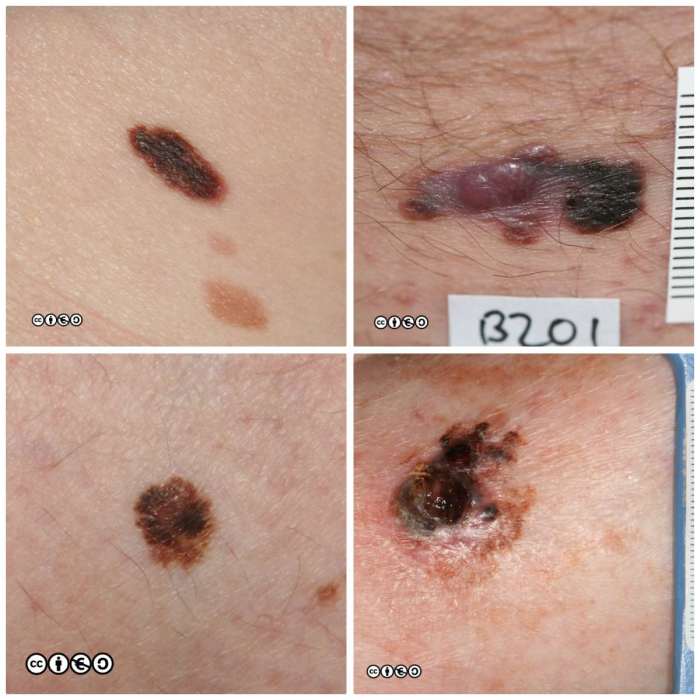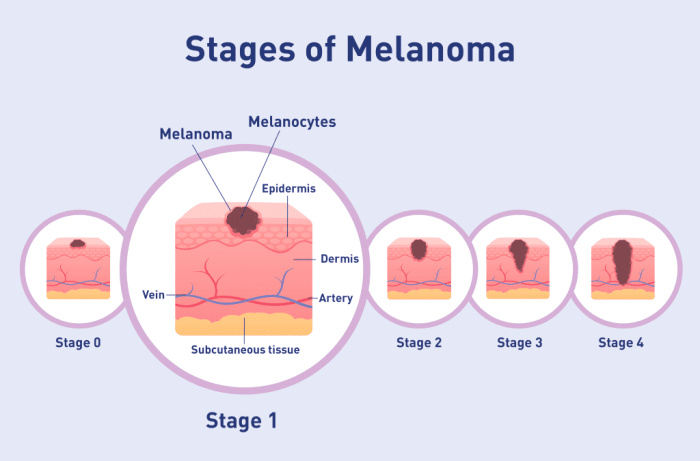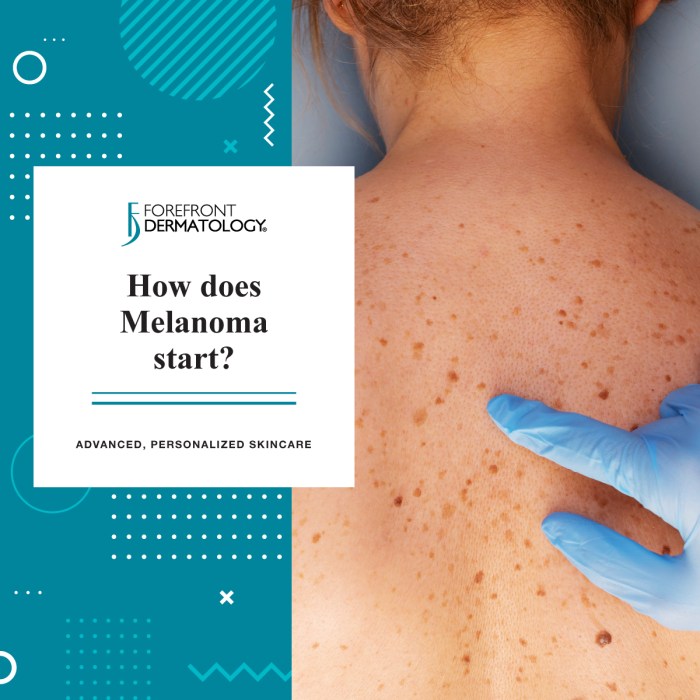Melanoma staging what it means and reveals – Melanoma staging, what it means and reveals, is crucial for understanding the progression and potential outcomes of this serious skin cancer. This guide delves into the specifics of melanoma staging, exploring the different stages, their characteristics, and the factors influencing them. From understanding the descriptors used to the impact on treatment options, we’ll unpack the complexities of this vital process.
The various stages of melanoma, from early detection to advanced cases, are explained. We’ll examine how tumor size, depth, lymph node involvement, and distant metastasis affect the staging and the choices that doctors make about treatments. Different staging systems, like AJCC and TNM, are also discussed. The information will be supported by visual representations, tables, and flowcharts to make the process clearer.
Defining Melanoma Staging

Melanoma staging is a crucial process in determining the extent of melanoma and guiding treatment decisions. It provides a standardized way to describe the characteristics of a melanoma, which helps medical professionals understand the risk of the disease spreading and develop a personalized treatment plan. Understanding the different stages and factors considered in staging is essential for both patients and healthcare providers.Melanoma staging classifies the cancer based on its size, depth, presence of lymph node involvement, and whether it has spread to distant parts of the body.
This classification system, like a roadmap, guides clinicians in choosing the most appropriate treatment strategies. A deeper understanding of the different stages and associated factors helps individuals understand their prognosis and what to expect during treatment.
Melanoma Stage Descriptions
Melanoma is categorized into different stages, ranging from Stage I to Stage IV, reflecting the progression and spread of the cancer. Each stage signifies a different level of severity and potential for recurrence or metastasis. Stage I melanoma is typically confined to the initial site, while Stage IV indicates that the cancer has spread to distant organs.
Factors Considered in Melanoma Staging, Melanoma staging what it means and reveals
Several factors are taken into account when determining a melanoma’s stage. These factors include the size of the tumor, the depth of penetration into the skin, the presence of lymph node involvement, and the presence of distant metastasis. The extent of these factors directly correlates with the stage assigned.
Stage Characteristics Table
| Stage | Tumor Size (mm) | Tumor Depth (mm) | Lymph Node Involvement | Distant Metastasis |
|---|---|---|---|---|
| Stage I | Up to 20 mm | Up to 1.0 mm | No | No |
| Stage II | 20-40 mm | 1.1-4.0 mm | No | No |
| Stage III | Any size | Greater than 4.0 mm | Present in regional lymph nodes | No |
| Stage IV | Any size | Any depth | Present in regional or distant lymph nodes | Present in distant organs (e.g., lungs, liver, brain) |
For example, a Stage I melanoma would typically be a small tumor (less than 20 mm) that hasn’t penetrated deeply into the skin (less than 1.0 mm), and hasn’t spread to lymph nodes or distant organs. Conversely, a Stage IV melanoma indicates a more advanced disease, with the tumor potentially any size and depth, and the presence of the cancer in distant organs.
Understanding Stage Descriptors: Melanoma Staging What It Means And Reveals
Melanoma staging is crucial for determining the appropriate treatment plan and predicting prognosis. Understanding the specific descriptors used in the staging system is vital for both patients and healthcare professionals. These descriptors provide detailed information about the extent of the melanoma, allowing for a more personalized approach to care.The descriptors used in melanoma staging systems encompass various aspects of the disease, including the size and depth of the primary tumor, the presence and extent of lymph node involvement, and the presence of distant metastasis.
Each of these factors contributes to the overall stage and thus influences the potential course of treatment and expected outcomes.
Tumor Size
Tumor size is a key indicator of the potential aggressiveness of the melanoma. Larger tumors generally pose a greater risk. Tumor size is measured in millimeters (mm) from the largest dimension of the tumor. For example, a tumor measuring 10 mm across is considered larger than a tumor measuring 5 mm. Accurate measurement is crucial, and often performed by a dermatologist or other healthcare professional trained in skin cancer diagnosis.
Tumor Depth
Tumor depth is another critical factor in melanoma staging. The depth of the tumor invasion into the skin and surrounding tissues correlates strongly with the likelihood of the melanoma spreading to other parts of the body. Depth is measured in millimeters (mm) from the top of the skin surface to the deepest part of the tumor. The Breslow thickness measurement is a common method used to quantify tumor depth.
Clinicians utilize specialized instruments and techniques to obtain precise measurements. For instance, a melanoma with a Breslow thickness of 1 mm is considered less aggressive than one with a thickness of 4 mm.
Lymph Node Involvement
Lymph node involvement is a significant predictor of melanoma progression. If melanoma cells have spread to lymph nodes, it indicates a higher risk of metastasis to other parts of the body. The presence and extent of lymph node involvement are classified as either positive or negative. Positive involvement means melanoma cells are found in the lymph nodes, while negative involvement indicates no evidence of melanoma cells in the lymph nodes.
Understanding melanoma staging is crucial; it reveals the extent of the cancer’s spread. For instance, knowing the details of stage 3 lung cancer, like what is stage 3 lung cancer life expectancy , can help paint a broader picture of the challenges and potential outcomes. Ultimately, melanoma staging helps doctors and patients alike navigate the complexities of treatment and prognosis.
Different types of lymph node involvement include single positive lymph nodes or multiple positive lymph nodes. A patient with involvement in regional lymph nodes may have a better prognosis compared to a patient with distant metastasis.
Distant Metastasis
Distant metastasis signifies the spread of melanoma to organs or tissues distant from the primary tumor site. This represents a more advanced stage of the disease with a more complex prognosis. Distant metastasis can manifest in various ways, and its location often influences the treatment approach and expected outcome. Different levels of distant metastasis are categorized based on the affected organs or systems, and include organ involvement (e.g., liver, lung) and the extent of the involvement.
The presence of distant metastasis, regardless of the site, typically signifies a more aggressive disease.
Summary Table
| Descriptor | Definition | Clinical Implications |
|---|---|---|
| Tumor Size | Measured in millimeters (mm) from the largest dimension of the tumor. | Larger tumors generally indicate a higher risk of progression. |
| Tumor Depth | Measured in millimeters (mm) from the skin surface to the deepest part of the tumor. | Greater depth correlates with a higher risk of metastasis. |
| Lymph Node Involvement | Presence of melanoma cells in regional lymph nodes. | Positive lymph node involvement signifies a higher risk of distant metastasis. |
| Distant Metastasis | Spread of melanoma to organs or tissues distant from the primary tumor. | Indicates a more advanced stage with a complex prognosis, requiring aggressive treatment. |
Implications of Melanoma Stage
Melanoma, a serious form of skin cancer, is categorized into stages to help determine the extent of the disease and predict its potential outcome. Understanding the stage is crucial for tailoring appropriate treatment and managing expectations. The stage of melanoma significantly impacts the prognosis, treatment options, and potential outcomes for individuals.Staging provides a framework for clinicians to assess the severity of the disease and make informed decisions regarding the best course of action.
This assessment considers factors such as the size and location of the primary tumor, the presence of regional lymph node involvement, and the presence of distant metastasis.
Impact on Prognosis
Melanoma stage directly correlates with the likelihood of survival. Early-stage melanoma, typically localized to the skin, has a much higher survival rate compared to advanced-stage melanoma, which may have spread to other parts of the body. Factors like the depth of the tumor penetration, the presence of ulceration, and the presence of lymphovascular invasion all contribute to the risk assessment.
Prognosis is a prediction of the likely course of the disease, taking into account the stage and individual patient characteristics.
Effect on Treatment Options
The stage of melanoma significantly influences the choice of treatment. For localized melanoma, surgical excision is often the primary treatment, aiming to remove the tumor completely. For melanoma that has spread to regional lymph nodes, lymph node dissection, radiation therapy, or both may be necessary. In advanced stages, chemotherapy, targeted therapies, or immunotherapy are used to shrink tumors or slow the spread of the disease.
Treatment decisions are personalized and involve a multidisciplinary approach, considering the patient’s overall health, preferences, and the specifics of their melanoma.
Melanoma staging reveals crucial information about the cancer’s spread. Understanding the stage helps doctors determine the best treatment approach. It’s fascinating to consider how a lifestyle change like quitting alcohol for a month, as detailed in this article about what happens when you quit alcohol for a month , can impact your overall health. This, in turn, could affect how the melanoma is handled and the potential for positive outcomes.
Ultimately, knowing the stage of melanoma is critical for effective treatment planning and patient care.
Potential Outcomes and Survival Rates
Survival rates vary significantly depending on the stage of melanoma. Early-stage melanoma has a very high cure rate, often exceeding 90% with appropriate treatment. However, survival rates decrease as the stage progresses. For example, melanoma that has metastasized to distant organs presents a more challenging prognosis, with survival rates potentially lower, though still with ongoing advances in treatment.
Statistical data from large-scale studies provide estimates for the likelihood of survival at different stages.
Treatment Approaches by Stage
The intensity and duration of treatment are influenced by the melanoma stage. Localized melanoma is often treated with surgical excision, potentially followed by adjuvant therapies like radiation, depending on the thickness and other factors of the tumor. For regional melanoma, the treatment may include surgical removal of lymph nodes, radiation therapy, or chemotherapy. In metastatic melanoma, systemic therapies, such as immunotherapy or chemotherapy, are the primary treatments.
Treatment intensity often involves more frequent and aggressive approaches in later-stage melanoma to address the broader spread of the disease.
Surgical Options
Surgical options for melanoma vary based on the stage. In early-stage melanoma, surgical excision is often sufficient. However, in more advanced stages, more extensive surgeries, including lymph node dissections, may be necessary. Surgical procedures are meticulously planned and executed, taking into account the tumor’s location, size, and depth, aiming for complete removal. Surgical margins are critical in preventing recurrence.
Radiation Therapy
Radiation therapy plays a role in treating melanoma, particularly in cases of regional spread or in areas where surgery is challenging or not possible. Radiation is often used to reduce the size of tumors or to treat residual disease after surgery. The specific radiation protocols are determined based on the stage and location of the tumor.
Chemotherapy
Chemotherapy is an important part of the treatment for advanced-stage melanoma. Various chemotherapy drugs are used to target cancer cells and slow the growth or spread of the disease. The choice of chemotherapy agents and the frequency of treatment depend on the patient’s overall health and the specific type of melanoma.
Immunotherapy
Immunotherapy has emerged as a significant treatment option for melanoma, particularly in advanced stages. Immunotherapy works by boosting the body’s immune system to recognize and destroy cancer cells. Various immunotherapy agents are available, each with specific mechanisms of action and potential side effects. The decision to use immunotherapy is individualized, considering the patient’s specific condition.
Melanoma Staging Systems
Navigating the complexities of melanoma diagnosis often involves understanding the stage of the disease. Staging systems provide a standardized framework for classifying melanoma based on its characteristics, aiding in treatment planning and prognosis. These systems help healthcare professionals determine the extent of the cancer’s spread and guide decisions about the most appropriate course of action.
Different Melanoma Staging Systems
Various staging systems exist, each offering a unique approach to categorizing melanoma. The most widely recognized and used systems are the American Joint Committee on Cancer (AJCC) and the TNM (Tumor, Node, Metastasis) system. These systems, while sharing common goals, employ different methodologies and criteria. Understanding their similarities and differences is crucial for interpreting melanoma reports.
Comparison of Staging Systems
The table below highlights key differences and similarities between the AJCC and TNM systems, showcasing their distinct approaches to melanoma staging.
| Feature | AJCC | TNM |
|---|---|---|
| Primary Focus | Overall tumor characteristics, including depth, ulceration, and presence of regional lymph node involvement. | Detailed assessment of the tumor size (T), lymph node involvement (N), and presence of distant metastasis (M). |
| Depth of Invasion | Central to determining stage, using specific depth classifications. | Depth of invasion is a component of the T category. |
| Regional Lymph Node Involvement | Evaluated through clinical examination, imaging, or biopsy. | Assessed based on the presence or absence of metastasis in regional lymph nodes. |
| Distant Metastasis | Considered as part of the overall stage classification. | Classified as M0 (no metastasis) or M1 (presence of metastasis). |
| Use Cases | Widely adopted by clinicians for treatment planning and prognosis assessment. | Frequently employed by oncologists and pathologists for standardized reporting. |
Factors Influencing Staging System Choice
The selection of a specific staging system often hinges on several factors. Clinicians may consider the type of facility, the specific needs of the patient, and the available resources. For instance, a hospital with advanced pathology capabilities might lean towards a system with more nuanced criteria.
Illustrative Flowchart of AJCC Melanoma Staging
This flowchart illustrates the process of determining melanoma stage using the AJCC system, a popular choice for its comprehensive approach.
Understanding melanoma staging is crucial for comprehending the extent of the disease. It reveals the size, location, and spread of the cancer, impacting treatment decisions. Navigating the emotional toll of caring for someone with dementia can be challenging, and joining a support group like dementia caregiver support group can offer invaluable emotional and practical assistance. Ultimately, accurate staging information empowers patients and their families to make informed choices about their melanoma journey.
Note: This is a simplified representation; the actual process involves detailed clinical evaluation and pathology analysis.
Start → Clinical Evaluation (skin examination, patient history) → Biopsy/Imaging (confirming diagnosis and extent of disease) → Pathological Analysis (depth of invasion, ulceration, regional lymph node involvement) → TNM Categorization (assigning T, N, and M categories) → Stage Determination (combining T, N, and M categories) → Prognosis and Treatment Plan
Factors Influencing Staging

Melanoma staging is a complex process that considers various factors beyond just the size and depth of the tumor. Understanding these influences is crucial for predicting the course of the disease and developing appropriate treatment strategies. These factors range from the patient’s inherent characteristics to the environment’s potential role in disease progression.Beyond the basic measurements, factors like the patient’s overall health, location of the melanoma, and even their genetic makeup play significant roles in determining the stage of the disease.
These factors allow for a more nuanced understanding of the potential risks and personalize treatment approaches, ultimately improving patient outcomes.
Clinical Factors Affecting Staging
Clinical factors, those observable or measurable characteristics, are paramount in melanoma staging. These include the size and depth of the primary tumor, the presence of ulceration, and the extent of lymph node involvement. Accurate assessment of these factors is crucial for determining the appropriate treatment and predicting the likelihood of recurrence or metastasis.For instance, a melanoma located on the face, with a deeper invasion, might be staged higher compared to a smaller melanoma on the back, even if both are similar in size.
This reflects the potential for increased risk of regional spread and metastasis from certain locations. Similarly, a patient with a pre-existing medical condition like diabetes or a weakened immune system might face a different prognosis compared to a healthy individual. These clinical details are carefully integrated into the staging system to provide a more comprehensive picture of the patient’s risk profile.
Genetic Factors in Melanoma Staging
Genetic predispositions play a significant role in melanoma development and progression. Certain genetic mutations, such as those in the BRAF gene, can influence the aggressiveness of the disease. Individuals with a family history of melanoma or those carrying specific genetic mutations might be at a higher risk of developing more aggressive forms of melanoma, necessitating closer monitoring and potentially earlier interventions.
Researchers are actively exploring the intricate relationship between specific genetic variations and melanoma progression.For example, a patient with a known genetic predisposition to melanoma might be placed in a higher risk category even if the initial tumor appears relatively benign. This understanding allows for proactive management and targeted interventions, ultimately improving long-term outcomes.
Environmental Factors in Melanoma Staging
Environmental factors, like sun exposure, also influence melanoma staging. Prolonged and intense sun exposure increases the risk of developing melanoma. Individuals with a history of extensive sun exposure or those living in regions with high UV radiation might be more likely to have advanced melanoma at diagnosis.For example, a farmer who spends significant time outdoors and has a history of severe sunburns is at a higher risk for a more advanced melanoma than someone with limited sun exposure.
This underscores the importance of sun protection measures and awareness of risk factors related to sun exposure.
Categorization of Influencing Factors
| Category | Factor | Example |
|---|---|---|
| Clinical | Tumor size and depth | A 4mm deep melanoma will be staged differently than a 1mm deep melanoma |
| Clinical | Presence of ulceration | A melanoma with ulceration has a higher risk of spread |
| Clinical | Lymph node involvement | Metastasis to regional lymph nodes increases the stage |
| Clinical | Patient’s age | Younger patients might have a different prognosis |
| Clinical | Overall health | Pre-existing conditions like diabetes |
| Genetic | Genetic mutations | Presence of BRAF mutations |
| Genetic | Family history | Family history of melanoma |
| Environmental | Sun exposure | Prolonged exposure to UV radiation |
| Environmental | Geographic location | Regions with high UV index |
Visual Representation of Melanoma Stages
Seeing melanoma stages visually can significantly aid in understanding the progression of the disease. Visual representations, when done correctly, allow for easier comprehension of the relationship between the size, depth, and location of the melanoma and its potential risk. This understanding is crucial for both patients and healthcare professionals in making informed decisions about treatment and monitoring.
Melanoma Stage Progression
Visual depictions of melanoma stages highlight the progression from early, often treatable stages to later, more advanced stages. This progression is characterized by increasing size, depth, and potential for spreading. Understanding these visual markers can help in early detection and appropriate treatment.
| Stage | Visual Representation | Description |
|---|---|---|
| Stage 0 (in situ melanoma) | A flat, brown or black spot, sometimes with irregular borders. | A precancerous lesion, the melanoma cells are contained within the epidermis. It appears as a discoloration, often with uneven edges. It is usually small and doesn’t extend into deeper layers of skin. |
| Stage 1 Melanoma | A mole-like lesion that may be raised, asymmetrical, or have irregular borders. It may have different colors, ranging from brown to black. The diameter is usually less than 6 millimeters. | Stage 1 melanoma involves a growth that has penetrated the epidermis (the outermost layer of skin) and possibly into the dermis (the middle layer). The melanoma cells are confined to the upper layers of the skin, and the risk of spreading is low. The lesion is typically less than 2 centimeters in diameter. |
| Stage 2 Melanoma | A slightly larger and raised lesion with varying shades of brown, black, or sometimes even red or white. The lesion may have uneven borders and be ulcerated. The diameter is usually between 6 and 15 millimeters. | In stage 2, the melanoma has grown deeper into the dermis. It may be thicker than in stage 1, and there might be evidence of some invasion into the deeper skin layers. The risk of spreading to other parts of the body is still relatively low compared to later stages. |
| Stage 3 Melanoma | A more noticeable lesion, potentially larger than 2 centimeters in diameter, with noticeable thickness and involvement of nearby lymph nodes. The lesion may have an ulcerated or bleeding surface. | Stage 3 melanoma indicates that the cancer has spread to nearby lymph nodes, often showing as a swollen or hardened area near the affected skin site. The size of the primary lesion is likely larger, and the depth of penetration into the skin is greater than in earlier stages. |
| Stage 4 Melanoma | A lesion that may be large, ulcerated, and/or bleeding. It may have spread to distant organs, such as the lungs, liver, or brain. The lesion’s appearance can vary significantly depending on the location of the spread. | Stage 4 melanoma represents a more advanced stage with distant metastasis. The cancer has spread beyond the original skin site and lymph nodes to other parts of the body. The visual appearance may vary depending on the location of the secondary tumors. |
Visual Clues for Early Detection
Recognizing the key visual characteristics of melanoma at different stages is crucial for early detection. These characteristics can include changes in size, shape, color, and texture of a mole or skin lesion. Early detection significantly improves the chances of successful treatment and favorable outcomes. Visual representations of melanoma progression can highlight the subtle differences between normal moles and early-stage melanoma.
Outcome Summary
In conclusion, melanoma staging provides critical information for both patients and medical professionals. Understanding the different stages, descriptors, and influencing factors empowers informed decisions regarding treatment and prognosis. By grasping the implications of melanoma stage, individuals can better navigate the complexities of this disease. This guide aims to provide a clear and comprehensive understanding of the topic, enabling a better understanding of melanoma staging.




